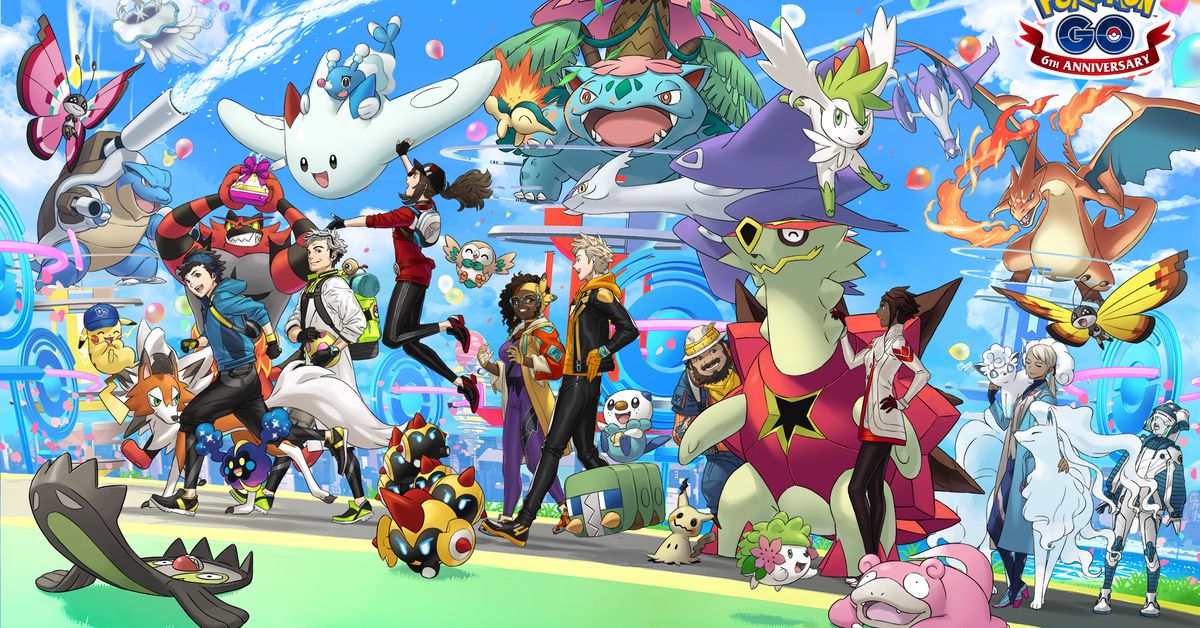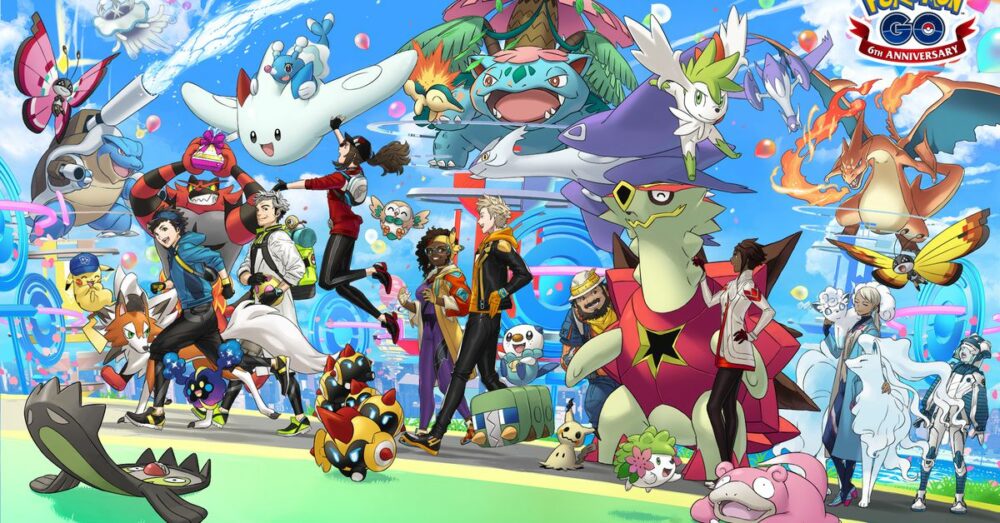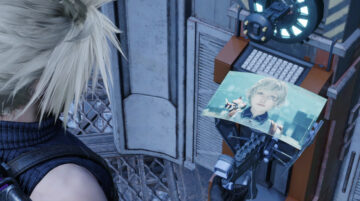
Niantic is changing how Pokémon Go’s Remote Raids work. The company behind the mobile gotta-catch-’em-all game is raising the price of Remote Raid Passes and limiting the number of Remote Raids that players can do in a single day. Niantic says that Raids played far away from Gyms have not only become a shortcut to play, but have “come to dominate the experience of playing Pokémon Go in a way we never intended.”
Here’s how pricing is changing: The price of a single Remote Raid Pass will increase to 195 PokéCoins (up from 100 PokéCoins); and the price of a Remote Raid Pass three-pack will increase to 525 PokéCoins (up from 300 PokéCoins). Players may be able to earn a Remote Raid Pass from Research Breakthroughs, however.
Niantic is also limiting the number of Remote Raids players can participate in per day, up to a maximum of five — though the company notes that may change (and increase) for special events. Niantic is further incentivizing in-person raids by rewarding players with additional XL Candy if they participate in five-star Raids.
“We plan to keep Remote Raid Passes as part of Pokémon Go,” the developer said in a blog post. “However, we believe this change is necessary for the long-term health of the game, and we do not make it lightly. We feel this is a necessary step toward our goal of preserving and improving the unique experience of playing Pokémon Go—a game we hope you continue to enjoy long into the future.”
For more information about the change, Polygon spoke to Ed Wu, VP of Pokémon Go at Niantic. You can read an edited version of our conversation below, which begins with Wu explaining the thought process behind the changes.
Ed Wu: As you might imagine, with any change of this kind, we’re going to really evaluate every possible option, look at a bunch of data and think through a lot of different plans. But at the end of the day, the actual changes that we’re making are quite simple. We’re going to raise the price of Remote Raid Passes, and we’re going to put a cap on daily usage. And there’s some game balancing changes we’ll make that are in addition to that: We’ll increase the XL Candy from five-star raids, as well as include a chance for Remote Raid Passes to be delivered in Research Breakthrough rewards. We do plan to keep Remote Raid Passes as part of Pokémon Go, but at the core, this change is necessary for the long-term health of the game, and for Niantic’s principles of getting folks outside and exploring the world together.
When we initially designed the raids feature in 2017, it was the first major feature post-launch that encouraged people to get together in the real world at the same time in the same place. As we spun out from Google, I was the manager and lead of the Pokémon Go team who designed much of the technical architecture, and also built much of the raids feature itself, and led the team that built it. [Raiding] was one of the first promises that we made to the community in our launch trailer, as you might remember — and the reaction to the launch of the feature in 2017 was incredibly positive. Millions of people were actually raiding together on the streets and in the parks in the real world. It was incredibly heartening to see.
As you might imagine, in 2020, all that had to come to a stop in a real sudden way. Players all over the world stopped having that ability to come together and meet up in real life to play Pokémon Go. And so we intended to temporarily adjust the game by introducing Remote Raid Passes to allow folks to continue to have some of the magic of playing together, even though they could not necessarily be physically together.
Fast forward three years and the world has largely moved back to the outdoors. And at the same time, we haven’t made changes to Remote Raid Passes in the kind of magnitude that will be necessary to stop them from dominating the experience of playing the game in a way that we never intended. Remote Raids, frankly, have become a shortcut to playing the game, and we’ve seen an imbalance in the game. The current price of Remote Raid Passes is distorting that economy and it’s frankly making the game unsustainable in the long term. So really, in order to continue to operate a game that is sustainable for years to come, we’ve decided to raise the price of Remote Raid Passes, in addition to having a daily cap. We know this is going to be a really big change and we’re empathetic to that. I want to emphasize that this is not about short-term revenue. And I think the cap goes to that point, right? This is really about making the game sustainable for years [and] decades to come and continuing to get folks outside and explore the world together, which is the core value that we really believe that Pokémon Go brings to folks’ lives.
Polygon: I am curious if you could explain a bit more about how you see Remote Raids and Remote Raid Passes distorting the economy of Pokémon Go. Can you tell me a little bit more what that means?
I think it’s actually easiest to think back to the original raids mechanic to see why that’s the case. In order to pull off a raid when we initially launched it, you had to find a few — maybe 10 to 20 of your friends — other trainers, family members, or members of the community and bring them together at the same time and same place, attempt a raid, and hopefully succeed at it. Then, if you wanted to do another raid, you’d walk together as a group for 10 to 15 minutes to the next location. Remote Raids shortcuts, all of that, right? It means that folks can stay in one place and go from one raid to the next over and over and over again. And like any game that has an unbounded limit to those kinds of attempts, the economy is going to run off the rails. It’s going to dominate the overall sales and game economy for the whole of the game. So in that way, Remote Raid Passes really need to be, I think […] placed in a position where there’s a value differential between the convenience it offers from a price point, as well as an overall cap to ensure that it does not overtake and dominate the economy as it does today.
Are you saying that the primary way that people are spending on Pokémon Go is on Remote Raid Passes compared to, say, research tickets or PokéCoins? When you talk about this being unsustainable in the long term, it might be difficult for people to parse that if you can sell 10 to 15 Remote Raid Passes to a person in a day, how is that not helpful to the economic health of Pokémon Go?
What is the most dominant SKU on a day by day basis differs from a day by day basis, right? At different times, different purchase products may dominate. That said, the issue with Remote Raid Passes is one of: We don’t want to create a transactional relationship with collecting and finding incredible legendary Pokémon. We don’t want that to be something where you do this thing over and over again, with no limits until you finish and then you just stop playing the game. That’s unsustainable and inconsistent with both the mission of exploring the world as well as the nature of Pokémon themselves. Like any other game, we have to think carefully about What are the most epic adventures that you’re having with the game, and that the value is just as much from the journey as it is from the ultimate experience, which is Raids. So much of the value that folks get out of Pokémon Go is actually that social interaction — the walking, the exercise, the exploration that they do together. By allowing the shortcut to that [with] a premium raid pass, we’re actually taking away much of the value that is unique to our product and differentiates it from pretty much every other thing out there.
I’m not doing more than five remote raids in a day like that. That’s not valuable to me. But I think this is going to read to most people as purely a disincentive for Remote Raid Passes. How instead are you incentivizing people to play the game in the fashion that you think aligns with Niantic’s philosophy? Obviously, Kecleon is one of the ways that you’re incentivizing people to go and visit Poké Stops, same with Scatterbug and Vivillon. But I’m curious what efforts you’re doing to incentivize this more. I know you’ve got in-person-only Elite Raids, but those, you know, those can be challenging to people with time restrictions. What are you doing to make up for this disincentive, this lack of convenience for players?
A few answers to this question. I’ll start with some that are tactical to this specific change, and then I’ll broaden it to some of our wider features. The first is that part of the change is actually increasing the amount of XL Candy at our five-star raids, so that trainers right now who feel the need to do many, many Remote Raids in order to level up one of their Pokémon [still get rewarded]. Our intent has never been to lean deeply into monetization from a small number of users that goes way deep into that tail. That has historically not been the approach that we’ve taken towards the value that we want folks to be able to derive from the game. And we’re making this change of increasing the amount of XL Candy to provide a balance, I wouldn’t necessarily say an incentive, but a balance that actually is consistent with our values, when it comes to how we want to operate the business, which is to have a broad base of folks who really find value, and that we’re not just leaning in on a very small number of folks who do the same experience over and over and over again. So from a tactical perspective, that’s one of the ways that we’re approaching it for this specific change.
To your broader point, we absolutely are continuing to lean into features like Kecleon or Vivillon. Those features really did inspire folks to explore the world and send postcards to each other, from all around the planet. And we’ve got an incredible new slate of features that are coming up this summer that I’m incredibly excited about. You know, this is the message that we’re bringing today: We’ve got our focus and attention on this specific balancing change. The team is incredibly hard at work at huge new features that I really believe are going to fundamentally change the game.
One thing that I’m very excited about the development for the summer is that it reminds me of the development that we did in 2017 for raids, or in 2018 for gifting and trading, or buddies afterwards. It’s got that level of engagement and excitement from the team for the size and shape of the features that we believe are going to change the way that folks play Pokémon Go and inspire them to actually explore the world together in the same way that those features did. So I have nothing to announce yet. But I think that’s our core focus right and keep our eyes on the ball of let’s create new, exciting experiences, and make sure that we’ve got the game’s economy in a great place going into that, so that folks will be inspired to go out there and experience it for themselves.
When you were talking about the thin tail of the audience that will probably be affected by this change, they’ll also be the most vocal about this. When I’ve spoken to people at Niantic before, they said some of these kinds of changes are relevant to 0.2% of the overall player base — people who are going to be responding on Twitter or on The Silph Road, they’re going to be the vocal ones who were say, Actually, I need my 10 Remote Raids a day.
I don’t want to marginalize their voices, because they’re among the most enthusiastic players of our game, who really do carry our message out into the wider community. I really think one of Pokémon Go’s traits, though, is its diversity of audience. One of the things I often note to my team is that when I look at the data, the median player of Pokémon Go is probably someone like a Singaporean grandma, who walks for 30 minutes to an hour a day with her senior group in the morning to catch Pokemon and very, very occasionally raids, if at all. Those are folks who are playing daily, who are a core part of our audience, [and] who are actually an essential part of the entire distribution of this incredibly diverse community. So when we talk about the sustainability of the overall long-term game economy, we do have to pay attention to all of those segments. And so the dominance of Remote Raid Passes in a large and important part of our total player base does have to be addressed for the long-term overall health and sustainability of the game. So I don’t want to diminish the kind of impact of those changes on those folks. But I do want to highlight that the XL Candy changes in particular are meant to move folks back into a situation where they don’t feel like they have to put in dozens and dozens of Remote Raid Passes in order to stay up to date with the game.
Going back to additions like Kecleon and Vivillon, in-person Elite Raids, and the post- Community Day raid hours, can you talk a little bit about what the results of those additions have been like in terms of getting you closer to that philosophy? Are you seeing an uptick in people gathering in places? Are you seeing an uptick in new friend requests? Is there a way for you to measure the impact of those things in a way that makes you feel like those are on the right track? Or that you need to do more work there?
Actually, one of the most important projects I’ve worked on with our team over the past few years has been how to quantify that very question. And so what we actually came up with was a metric called real-world social interactions, which we can track by how much time folks are spending colocated playing the game together. And that number is up significantly this year, because of precisely the sort of changes that you’ve noted. Features like Elite Raids, those in real-life-only raids have inspired folks to come together and play together in real life. Many of the most engaged folks who we would expect to be the folks who are utilizing Remote Raid Passes the most actually, are some of the folks who play those in real life raid features the most. Sso that gives us the confidence that if we built the great features that actually inspire folks to go out in the real world, and we make sure that the game economy is well aligned towards encouraging them to do so, that we can make this change with a degree of confidence that we’ve got the data and history that backs it up. In the past year in particular, we’ve seen that real-world social interactions, that colocated kind of play time, goes up and up and up as folks have gotten more and more used to being out there together in the real world. We want to ensure that we have features that inspire them to do so.
I also wanted to ask about the other incentives that align with the philosophy. I feel like raid pools have, outside of the Elite Raids, that there haven’t been a ton of new additions I’d say the same as is true for Eggs; I’ve reached the stage of the game where I’m kind of hatching Eggs and completing Weekly Research tasks out of an obligation, but I’m not excited about what I’m getting out of them. Are there plans to also update those aspects of the game to push toward that philosophy?
Absolutely. So I think that your questions are incredibly prescient, because it actually hits on a number of different issues. First, your notes about the raid pool are precisely why we have to make this change. We don’t want to be in a position where our entire economy, our entire balance is devoted to OK, how can we squeeze the most out of the raid pool as possible? I think your notes there actually point to the unsustainability of the current approach. To some degree, it is also, I think, taking our eyes off the ball and making sure that the other parts of our game such as weekly research, and our incubator mechanics, are as exciting and have as full a set of new and interesting Pokémon to collect as there could be. So those are two ways that this unsustainability has actually manifested itself in reality. We are taking proactive steps as well to make sure that Pokémon are really exciting to collect in a number of different ways.
One I want to highlight here is the location card Pokémon that we did for Go Tour Vegas. I was very excited that folks had the chance to bind their memories of that time and place to a literal background that was beautifully designed. That really highlighted how special the Groudons and Kyogres that they caught there really were, right? So I think what you can see there is a glimpse into one of our many efforts to continue to bring location and memory and Pokémon all together in a way that’s truly special for every trainer.
- SEO Powered Content & PR Distribution. Get Amplified Today.
- Platoblockchain. Web3 Metaverse Intelligence. Knowledge Amplified. Access Here.
- Source: https://www.polygon.com/23663732/pokemon-go-remote-raid-pass-price-increase-daily-limit
- 100
- 2017
- 2018
- 2020
- a
- ability
- About
- ADDITION
- Additional
- additions
- affected
- All
- Allowing
- among
- amount
- Announce
- Another
- approach
- approaching
- architecture
- ARE
- around
- as
- aspects
- At
- attempts
- attention
- audience
- background
- ball
- base
- BE
- beautifully
- because
- become
- before
- behind
- believe
- between
- BIG
- bind
- Bit
- Blog
- breakthrough
- breakthroughs
- bring
- bringing
- brings
- broad
- broader
- built
- Bunch
- business
- by
- CAN
- candy
- Cap
- card
- carefully
- case
- Catch
- caught
- challenging
- chance
- change
- changes
- closer
- collect
- Collecting
- coming
- community
- company
- compared
- confidence
- consistent
- continue
- continuing
- convenience
- Conversation
- Core
- could
- create
- Curious
- Current
- data
- date
- day
- decades
- decided
- deep
- delivered
- designed
- Developer
- Development
- DID
- different
- difficult
- distribution
- diverse
- Diversity
- dominant
- dominate
- dozens
- Earn
- Economic
- economy
- efforts
- Eggs
- elite
- encouraging
- engaged
- engagement
- ensure
- Epic
- essential
- Evaluate
- events
- Every
- excited
- excitement
- Exciting
- Exercise
- expect
- experience
- Experiences
- explain
- exploration
- explore
- Exploring
- eyes
- family
- family members
- Fashion
- Feature
- Features
- finding
- finish
- First
- Focus
- For
- Forward
- friend
- Friends
- from
- full
- further
- future
- game
- Gathering
- getting
- gifting
- goal
- going
- great
- Group
- gyms
- Hard
- Have
- having
- Health
- helpful
- here
- Highlight
- Highlighted
- historically
- history
- hits
- hope
- Hopefully
- hours
- How
- How To
- HTTPS
- huge
- i
- imbalance
- Impact
- important
- improving
- in
- incentive
- Incentives
- incentivize
- Increase
- increasing
- incredible
- incredibly
- incubator
- information
- inspire
- inspired
- instead
- intent
- interaction
- interactions
- interesting
- Is
- issues
- IT
- ITS
- journey
- jpg
- kind
- lack
- large
- launch
- launched
- lead
- Led
- Legendary
- Level
- level up
- Life
- lightly
- like
- LIMIT
- limits
- Little
- lives
- location
- Long
- long-term
- Look
- Magic
- major
- make
- MAKES
- Making
- manager
- maximum
- May
- measure
- Mechanics
- Members
- memory
- Message
- might
- Millions
- minutes
- Mission
- Mobile
- monetization
- more
- morning
- move
- nature
- necessary
- need
- New
- New Features
- niantic
- noted
- notes
- number
- Obviously
- of
- Offers
- on
- One
- operate
- Option
- order
- original
- Other
- outdoors
- parks
- part
- participate
- particular
- passes
- Past
- Pay
- People
- perspective
- philosophy
- place
- places
- planet
- plans
- plato
- plato data intelligence
- platodata
- platogaming
- play
- player
- players
- Playing
- Point
- pokemon
- Polygon
- pool
- Pools
- position
- Positive
- possible
- post-launch
- Premium
- pretty
- price
- prices
- pricing
- primary
- principles
- proactive
- probably
- Process
- Product
- Products
- projects
- promises
- Provide
- purchase
- push
- question
- questions
- quite
- raid
- rails
- raise
- raising
- reaction
- read
- Real
- real world
- Reality
- relationship
- relevant
- Remember
- remote
- requests
- research
- restrictions
- Results
- revenue
- rewarding
- Rewards
- right
- road
- Run
- Said
- sales
- segments
- sell
- senior
- set
- short-term
- significantly
- Simple
- situation
- Size
- small
- So
- Social
- some
- something
- special
- specific
- Spending
- spun
- Squeeze
- Stage
- start
- stay
- step
- still
- stops
- succeed
- such
- summer
- Sustainability
- sustainable
- tactical
- taking
- talk
- talking
- Team
- Technical
- that
- The
- The Future
- The Game
- the world
- their
- Them
- themselves
- These
- thing
- things
- Through
- tickets
- time
- times
- to
- Today
- together
- Ton
- total
- towards
- track
- Trading
- trailer
- transactional
- ultimate
- unique
- up
- Update
- us
- users
- utilizing
- valuable
- value
- values
- VEGAS
- version
- Visit
- VOICES
- walk
- walking
- way
- ways
- weekly
- well
- What
- WHO
- wider
- Wider Community
- will
- with
- Work
- worked
- world
- would
- wu
- year
- years
- zephyrnet












